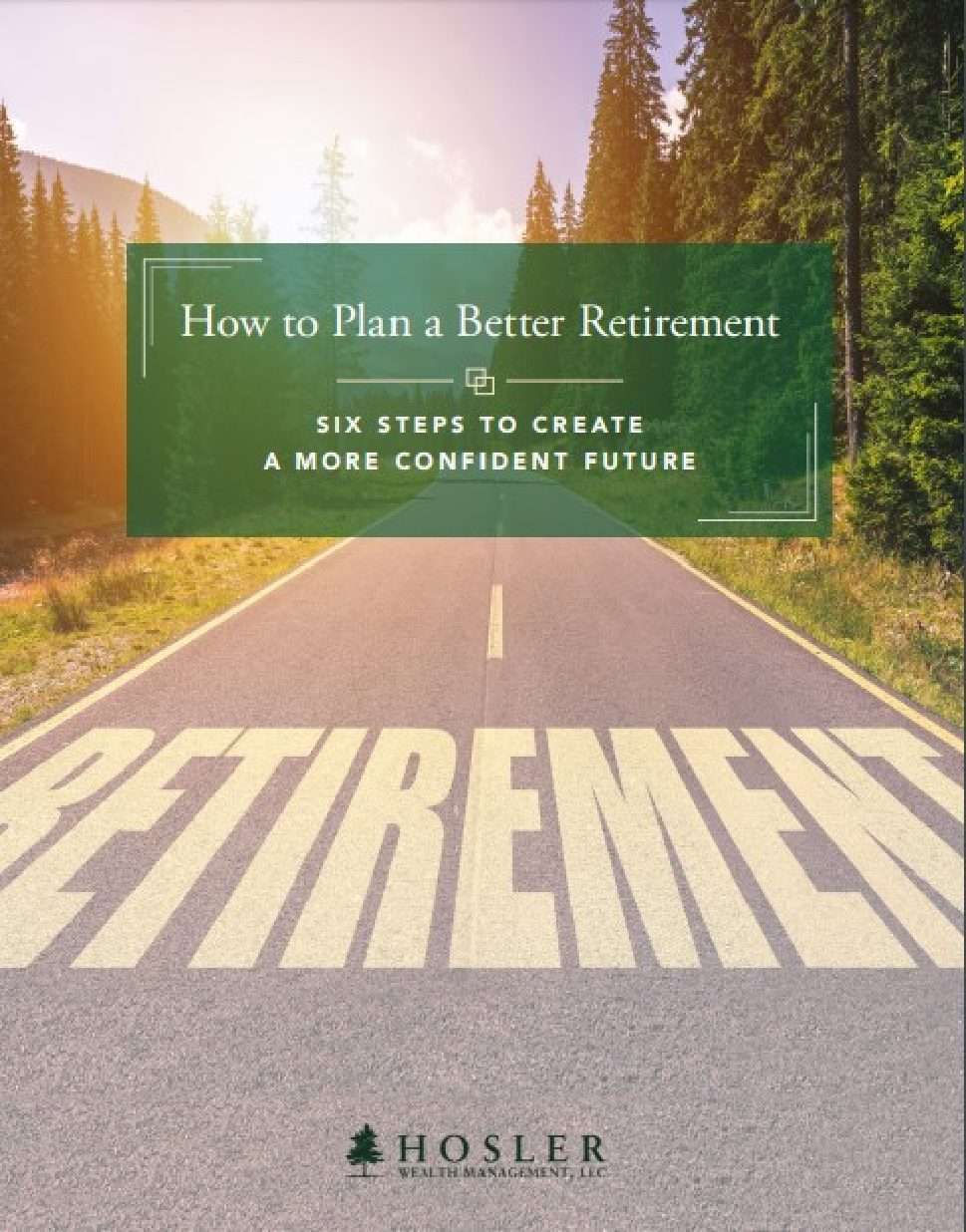Asset-based long-term care insurance is something Bruce Hosler and the team at Hosler Wealth Management work on frequently for our clients. Traditional long-term care will require you to pay a premium until you go on claim, and rates can often change. However, asset-based long-term care premiums are paid with assets; therefore, they can’t raise the premium or modify your terms.
For a married couple age 65, there is a 70 percent chance at least one of them will need long-term care. Rather than bet against those odds, this allows you to share some of that risk with an insurance provider.
Bruce explains how to choose the right coverage and avoid being “insurance rich and cash poor,” how much these policies can cost, and at what age you should begin exploring coverage. We also cover the misnomer that Medicare pays for long-term care; it does, but only in certain circumstances.
Bruce and Jon cover timeframes around application for coverage and processing of claims, how the claims payout, and what, if any, are the tax implications.
For more information about anything related to your finances, contact Bruce Hosler and the team at Hosler Wealth Management.
Call the Prescott office at (928) 778-7666 or our Scottsdale office at (480) 994-7342.
To listen to more Protecting & Preserving Wealth podcast episodes, click here.
Limitation of Liability Disclosures: https://www.hoslerwm.com/disclosures/#socialmedia
Podcast Host

Bruce Hosler is the founder and principal of Hosler Wealth Management, LLC., which has offices in Prescott and Scottsdale, Arizona. As an Enrolled Agent, CERTIFIED FINANCIAL PLANNER™ professional, and Certified Private Wealth Advisor (CPWA®), Bruce brings a multifaceted approach to advanced financial and tax planning. He is recognized as a prominent financial professional with over 27 years of experience and a seven-time consecutive *Forbes Best-In-State Wealth Advisor in Arizona. Bruce recently authored the book MOVING TO TAX-FREE™ Strategies For Creating Tax-Free Retirement Income And Tax-Free Lifetime Legacy Income For Your Children. www.movingtotaxfree.com.
In the Protecting & Preserving Wealth podcast, Bruce and his guests discuss current financial topics and provide timely answers for our listeners.
If you have a topic of interest, please let us know by emailing info@hoslerwm.com. We welcome your suggestions.
*2018-2024 Forbes Best In State Wealth Advisors, created by SHOOK Research. Presented in April 2024 based on data gathered from June 2022 to June 2023. 23,876 were considered, 8,507 advisors were recognized. Not indicative of advisor’s future performance. Your experience may vary. For more information, please visit.
Transcript
Jon “Jag” Gay: Welcome back to Protecting and Preserving Wealth. I am Jon Jag Gay, joined as always by Bruce Hosler of Hosler Wealth Management. Good be back with you, Bruce.
Bruce Hosler: Good to be with you, Jon. Thanks.
Jon: Talking about a topic that is going to be important to many of our listeners today, and that is asset-based, long-term care insurance.
Bruce. I’ve heard of long-term care insurance, but what is asset-based long-term care compared to traditional long-term care we’ve all heard of?
Bruce: Traditional long-term care is where you pay a premium every month or every year for your whole life until your health changes and then you go on claim.
Asset-based long-term care generally is if you think of reaching in your pocket and moving money from your right pocket to your left pocket, you move some of your assets over and then the premium is paid, and they can’t ever raise the premium on you. They can’t change the terms and make it worse for you or force you to give up some changes.
So, we’ve seen over the last few years, the traditional long-term care insurance companies are raising premiums and clients are having to think about lowering their coverage that they’ve been paying on for years. It’s become quite a problem in the industry.
Jon: Nobody wants to be in that situation. And honestly, Bruce, I’ve never wanted to have to live in a nursing home.
My grandmother was in a nursing home. It was not the best situation. If I don’t want to go into a nursing home, do I really need long-term care insurance?
Bruce: Yes, of course you do, Jon, because as a married couple there’s a chance, a 70% chance that one of you will need long-term care. Now, that doesn’t mean that you have to go into a nursing home. It just means that you might incur those expenses.
I want you to think about it. Do you want to be betting against a 70% chance?
Jon: Oof.
Bruce: That’s not what you want to do. So, if you have a high probability of needing care, you want to share the risk with the insurance company, so you don’t run your family out of money.
Jon: Okay. That’s fair. I’m thinking of 70% Chance in odds. I’m thinking about my NFL bets last weekend, but that’s another story altogether. I’ve heard of people talking about being insurance rich and cash poor. What does that mean?
Bruce: Well, I run into this frequently. You know, if someone has Alzheimer’s or that, and they’re in a memory care unit, it could be as much as eight, nine, $10,000 a month.
Jon: Oof.
Bruce: That could be very expensive. But we don’t want to buy so much insurance that we cover every dollar of that. Remember, people don’t stop receiving social security. They don’t stop having to take RMDs from their IRAs. So, what we want to do is just buy enough insurance, so we don’t impoverish the surviving spouse by the care of a spouse who needs long-term care.
Jon: Again, that’s back to every individual situation being different. Why you would want to talk to Bruce and the team at Hospital Wealth Management about this sort of stuff where you, you got a lot of moving parts and it’s not certainly one size fits all. So, what are the primary benefits of, as you’ve been talking about earlier, Bruce, an asset-based long-term care policy.
Bruce: So, the primary benefits are you can use it for at-home care, you can use it for assisted living, you can use it for a nursing home. You can use it for respite care. So, if you’re the caregiver and you need to take your loved one to a daycare for a couple of days to get a break, it can cover all of those.
Jon: Mm-hmm.
Bruce: But the main thing is, is when your health changes and you need assistance from one of the six activities of daily living. Then you have money that can be paid to help pay for that cost and not spend all your money down on this very expensive care. And it’s only going to get worse with all the baby boomers retiring right now.
Jon: Yeah, there’s a, there’s a lot of baby boomers who are going to put a large strain on the system, for sure. But that in mind, how expensive is asset-based, long-term care, and does it make a difference how old you are?
Bruce: Absolutely, Jon. It makes a difference. So, the sweet spot folks are between about 45 and probably early sixties, up to 65.
You want to be sure and secure your policy in that time, and obviously the earlier you’re able to do it, the better pricing that you can get. On my personal policy, Jon, I purchased a policy where I pay $7,500 once a year for 10 years, and then the policy is paid up and I never have to pay it again.
Jon: Wow.
Bruce: They can never raise the premiums. They can never drop the benefits. It increases with an inflation rider at 3% a year. So usually something like that where you pay it over a 10 or a 20-year period and then you’re paid up. That’s what we like to see people do.
Jon: I am going to be 42 in December, so that is, uh, a good nugget for me to file away.
And my wife is a couple years older than me, not much, and I don’t want to give away her age and upset her on the podcast.
Bruce: Yeah, don’t do that, Jon.
Jon: So, we’ve heard about people having to qualify for life insurance. Is the same thing true for long-term care insurance, having to qualify based on your health?
Bruce: Yes, it is. And really this asset-based long-term care is really a life insurance policy with a long-term care rider attached to it.
Jon: Okay.
Bruce: So, you do have to qualify, and depending on your health, you may not qualify. So, you want to get it younger when you’re sure your health is good. Don’t let this go without getting coverage folks.
Jon: What can you and your team do to help them qualify or even find out early if they won’t qualify?
Bruce: So, we have some questionnaires that help people look and see if they might qualify and what would disqualify them.
Also, the test that we see most people fail and they don’t need to is the memory test. So, during an interview on the phone with a nurse, they’ll give you 10 items, and you have to remember as many of them as you can. So, we teach people to use a visual image of, you know, they say VW, Elephant, Umbrella.
And so, you imagine a VW with an elephant standing on top of it and then holding an umbrella. And so, they do things to help them have, you know, remember everything, cuz we all struggle with that a little bit.
Jon: Yeah, I would’ve a hard time remembering that without a mnemonic device. My mom always taught me that as a kid. Mnemonic device, you need a little trick to remember things.
Bruce: Right.
Jon: All right, so what is the number one reason people may not qualify for long-term?
Bruce: So, if you are having some sort of walking problem, if you walk in with a cane.
Jon: Okay.
Bruce: We cannot even take an application for you.
Jon: Wow.
Bruce: So, people have knees, hips, things like that going out. You want to apply for this before you have one of those problems.
Jon: Got it. Okay. So, I’ve heard, and you allude to this a little bit earlier, Bruce, a lot of insurance companies are pulling out of long-term care, and I don’t know if that’s related to the baby-boomer thing you just mentioned, is that true? And what do our listeners have to watch out for?
Bruce: So, a lot of insurance companies in the last couple of years have stopped offering long-term care. They’re continuing to service the policies that they have, but they’re not offering anymore. And the reason is, is because early on the actuaries got it all wrong and these costs are much more expensive than they thought, and they thought they were going to have a lot of people cancel the policies.
Once you get a long-term care policy, you never want to give it up cuz you have that insurance and you’ve qualified for it. So yes, there’s a smaller group of insurance companies offering this type of coverage. So, it’s getting harder and harder to get.
Jon: Bruce, is there a deductible on this asset-based long-term care? And if so, how much?
Bruce: So, the deductible, they called an elimination period, Jon. And what that means is,
Jon: Mm-hmm.
Bruce: When you first go on claim, normally there’ll be 90 days that you have to pay those costs out of your pocket. And that’s the deductible and elimination period. Usually 90 days. So, if you figure your costs are $4000 or $5,000 a month, you need to be prepared for four months’ worth of expenses.
Jon: Hmm.
Bruce: Before this policy will kick in.
Jon: That’s really important to know. Does Medicare come into this? Don’t they pay for some long-term care?
Bruce: You know, that is a big misnomer, Jon. Medicare will pay for long-term care, but only under these circumstances. First of all, you have to be admitted to a hospital. And then once you’re released from the hospital, they only pay 21 days.
Jon: Wow.
Bruce: So, there’s not really that much coverage for it, and it doesn’t cover what people think that it does.
Jon: That’s a real eye opener for me. I had no idea. Okay, so once I have the asset-based long-term care policy we’re talking about today, what has to transpire for me to make a claim in that situation?
Bruce: So, there’s six activities of daily living.
You know, things like being able to dress yourself, eat, continents, memory, walk, transfer – that is to get up and out of a wheelchair or whatever you need to do like that. If you can’t perform those activities, that will trigger the ability to file a claim. You just have to have a doctor sign a letter for that usually.
Jon: Mm-hmm.
Bruce: And then you can begin going on claim.
Jon: So now we’ve gotten to the point where we’re on the claim, we filed the claim. How do most policies pay for the claims when I need care? And what’s the difference between reimbursement and indemnity?
Bruce: Reimbursement means you pay for the cost and the insurance company will reimburse you. The vast majority of policies are that way. The other type is an indemnity type policy, so that if you have a policy and you’ve qualified for long-term care, they will pay you a set amount every month, no matter what your situation is, what your costs are, you don’t have to be reimbursed. In different policies are indemnity policies, and they have both available.
It depends on what you want in the marketplace.
Jon: Got it. So, how long does it normally take to apply for and receive an asset-based long-term care policy?
Bruce: So again, it’s a life insurance policy with a long-term care rider. So, we have to apply, submit your healthcare information. The insurance company has to review all of it, get all the doctor’s offices to provide your medical records, everything like that.
So, I would tell most people to expect somewhere between 45 to 60 days on the short end, probably about 90 days on the long end.
Jon: You know, so you mentioned 45 kind of being the low end of that sweet spot Bruce. How young can someone be that wants to lock up one of these policies in a good word at that.
Bruce: Jon, that applies to you actually at your age at 42, you don’t get to apply yet.
Jon: Okay.
Bruce: So, the companies generally will not let you apply for long-term care until you’re 45 years old, but the earlier you do it, the longer they’ll let you pay that amount in. So
Jon: Hmm.
Bruce: At 45, you can actually get a period of over 20 years to make your payments for the long-term care policy and have it paid up.
So, then that can be less payment per year in order to do that. So, the younger you apply, the better off your chances are to keep the cost low and the benefits to grow if you have an inflation rider on there, to provide for this because as we know, inflation’s running rampant, going crazy right now in medical care and in long-term care especially, it’s going up.
So, you want to be sure and have an inflation rider on that policy. So 45, that’s when you want to start. As soon as you can, Jon.
Jon: Medical care costs were skyrocketing before all this recent inflation hit. That’s for sure. Uh, quick follow up on what you just said, Bruce. So, say I get the policy at 45 and I’ve got 20 years to pay it into so till I’m 65.
What happens if something happens to me health wise at 60 and I haven’t paid all of it yet? What happens if, you know, I get hit by the proverbial bus or whatever before I’ve paid all the way into the policy.
Bruce: So, depends on the policy. Some policies will say you’re covered and when you go on claim, then you don’t make any more premium payments.
Jon: Okay.
Bruce: Other ones will say because you guaranteed to pay the premiums for that period of time, you can go on claim and it will pay you, but you still have to make those payments for the remaining years.
Jon: Oh, okay. That makes sense. Okay, so do people have to recognize taxable income when they start receiving these benefits?
Bruce: So, the benefits of the policy depend. Now most policies are going to be what we call tax qualified. I would say like 97, 98% of them. And so, what that means if they’re tax qualified is if you have a long-term care policy and you go on claim, the benefits are not included in taxable income. You don’t have to pay taxes on them. They are received income tax free.
Jon: Good to know. Okay, so let me conclude with this question. It’s on my mind, I’m sure it’s on our listener’s minds as well. How long should someone plan on securing benefits for if they need long-term care? I mean, I heard the average need for a nursing home is two years. Should they buy coverage for longer than that?
Bruce: Jon, two years is the average stay in a nursing home, but many times a family is helping care for you before or after that. Normally, we like to see people buy coverage somewhere between four and six years, and that’s back to that insurance rich and cash poor. You can buy policies that are never ending. And in the rare case that you might have someone with Alzheimer’s for 10 years.
Jon: Yeah.
Bruce: But if you had six years coverage, that would cover the vast majority of everybody. And we think that for most people, that’s adequate care and adequate coverage for long-term care, four to six years of coverage.
Jon: Long-term care is something that if our listeners have not thought about, they really should think about it. Again, all you gotta do is look at the average cost of a nursing home these days, and do you wanna be preparing for this when you’re young and you’re healthy? Or do you wanna be behind the eight ball when it takes a turn? If you don’t have this coverage, it is so, so important.
Bruce: Very important, Jon. We recommend to all of our clients to consider this and put it in place, and we have done long-term care, asset-based long-term care for the vast majority of our clients.
Jon: And that is really good to know. And if our listeners want to come talk to you and the team at Hosler Wealth Management about long-term care or anything regarding their financial future planning, investing – best ways to reach you sir?
Bruce: They can reach us at the website, hoslerwm. That’s https://hoslerwm.com/. There’s a button right on there to schedule an appointment, or if you want to call the office in Prescott (928) 778-7666 or in Scottsdale, you can reach us at (480) 994-7342.
Jon: I always appreciate the time, Bruce. Talk again soon.
Bruce: Thanks Jon.
Jon: Securities and advisory services offered through Commonwealth Financial Network® member FINRA/SIPC, a registered investment advisor. Forward looking commentary should not be misconstrued as investment or financial advice.
The advisor associated with this podcast does not monitor for comments and any comments should be given directly to the office at the contact information specified. Any tax advice contained in this communication, including any attachments, is not intended or written to be used and cannot be used for the purpose of 1) avoiding federal or state tax penalties, or 2) promoting marketing or recommending to another party, any transaction or matter addressed herein. The accuracy, completeness, and timeliness of the information contained in this podcast cannot be guaranteed. Accordingly, Hosler Wealth Management, LLC does not warranty guarantee or make any representations or assume any liability with regard to financial results based on the use of the information in this podcast.
Comments are closed.




